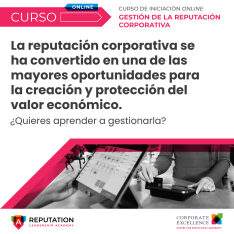Loading...
- Agenda 2030 & ODS (21)
- Alineamiento y Cultura Corporativa (21)
- Analytics & Big Data (4)
- Bienestar y Engagement (3)
- Chief Communications Officer (26)
- Co-Creación (2)
- Comunicación Externa (17)
- Comunicación Política (1)
- Consumidores (11)
- COVID-19 (14)
- Digitalización (19)
- Diplomacia Corporativa (3)
- Diversidad & Inclusión (18)
- Empleados (13)
- Empresa Con Futuro (8)
- Estrategia (37)
- Ética (19)
- Fake News y Desinformación (2)
- Global Issues (23)
- Gobierno Corporativo (15)
- Indicadores No Financieros (6)
- Innovación (18)
- Internacionalización (3)
- Liderazgo (80)
- Lobby (1)
- Marca Corporativa (24)
- Marketing (6)
- Medios Sociales (2)
- Propósito & Valores (46)
- Publicidad & Patrocinios (3)
- Rankings & Premios (3)
- Reputación Del CEO (10)
- Reputación País (1)
- Reporting No Financiero (3)
- Riesgo Reputacional (28)
- Sostenibilidad & Responsabilidad Social (32)
- Stakeholder Engagement (19)
- Storytelling & Narrativa (2)
- Tendencias (29)
- Valoración De Los Intangibles (9)
- Comunicación Interna (14)
- Transparencia (22)
Published by Unai Admin
18/07/2025
Published by Unai Admin
18/07/2025
Categories
Categories
Tags
- purpose-driven palgrave macmillan
- biblioteca corporate excellence
- dpmc
- propósito
- organizaciones con proposito
- carlos rey
- organizations
- uic
- purpose driven
- ideas
- better world
- cátedra dirección
- misiones
- gobierno corporativo de la uic barcelona
- palgrave macmillan
- propósito corporativo de la uic barcelona
- corporate excellence library
- chair management
- missions
- corporate purpose of uic barcelona
Categories
Tags
- purpose strength model
- dpmc
- tecnun
- propósito
- iese
- uic barcelona
- purpose-drive
- purpose driven organizations
- métricas
- indicadores
- purpose strength model®
- corporate excellence
- centre
- reputation leadership
- tecnun-escuela de ingenieros de la universidad de navarra
- cátedra dirección
- misiones
- gobierno corporativo de la universitat internacional de catalunya
- catedra de mujer
- sans-serif
- mso-bidi-font-family
- corporate excellence centre
- tecnun-school of engineers of the university of navarra
- department of missions
- corporate governance of the international university of catalonia
- chair of women
- leadership of iese
- measuring
- r&d
- «measuring the purpose strength»
- purpose strength model®
- propósito corporativo de la universitat internacional de catalunya
- purpose strength»
- missions
- corporate purpose
- chair management
Published by Unai Admin
18/07/2025
Página
of 3




